-

新人教版高中英语选修2Unit 5 Using langauge-Listening教学设计
The theme of this section is to learn how to make emergency calls. Students should learn how to make emergency calls not only in China, but also in foreign countries in English, so that they can be prepared for future situations outside the home.The emergency telephone number is a vital hotline, which should be the most clear, rapid and effective communication with the acute operator.This section helps students to understand the emergency calls in some countries and the precautions for making emergency calls. Through the study of this section, students can accumulate common expressions and sentence patterns in this context. 1.Help students accumulate emergency telephone numbers in different countries and learn more about first aid2.Guide the students to understand the contents and instructions of the telephone, grasp the characteristics of the emergency telephone and the requirements of the emergency telephone.3.Guide students to understand the first aid instructions of the operators.4.Enable Ss to make simulated emergency calls with their partners in the language they have learned1. Instruct students to grasp the key information and important details of the dialogue.2. Instruct students to conduct a similar talk on the relevant topic.Step1:Look and discuss:Match the pictures below to the medical emergencies, and then discuss the questions in groups.

新人教版高中英语必修3Unit 1 Festivals and Celebrations教学设计一
本板块的活动主题是“谈论节日活动”(Talk about festival activities),主要是从贴近学生日常生活的角度来切入“节日”主题。学生会听到发生在三个国家不同节日场景下的简短对话,对话中的人们正在参与或将要亲历不同的庆祝活动。随着全球化的进程加速,国际交流日益频繁,无论是国人走出国门还是外国友人访问中国,都已成为司空见惯的事情。因此,该板块所选取的三个典型节日场景都是属于跨文化交际语境,不仅每组对话中的人物来自不同的文化背景,对话者的身份和关系也不尽相同。1. Master the new words related to holiday: the lantern, Carnival, costume, dress(sb)up, march, congratulation, congratulate, riddle, ceremony, samba, make - up, after all. 2. To understand the origin of major world festivals and the activities held to celebrate them and the significance of these activities;3. Improve listening comprehension and oral expression of the topic by listening and talking about traditional festivals around the world;4. Improve my understanding of the topic by watching pictures and videos about different traditional festivals around the world;5. Review the common assimilation phenomenon in English phonetics, can distinguish the assimilated phonemes in the natural language flow, and consciously use the assimilation skill in oral expression. Importance:1. Guide students to pay attention to the attitude of the speaker in the process of listening, and identify the relationship between the characters;2. Inspire students to use topic words to describe the festival activities based on their background knowledge. Difficulties:In the process of listening to the correct understanding of the speaker's attitude, accurately identify the relationship between the characters.

新人教版高中英语必修3Unit 1 Festivals and Celebrations教学设计三
*wide range of origins(= a great number of different origins, many kinds of origins)*It featured a parade and a great feast with music, dancing, and sports. (=A parade and a great feast with music, dancing, and sports were included as important parts of the Egyptian harvest festival.)*.. some traditions may fade away and others may be established.(= Some traditions may disappear gradually, while other new traditions may come into being.)Step 6 Practice(1) Listen and follow the tape.The teacher may remind the students to pay attention to the meaning and usage of the black words in the context, so as to prepare for the completion of the blanks in activity 5 and vocabulary exercises in the exercise book.(2) Students complete the text of activity 5 by themselves.The teacher needs to remind the students to fill in the blanks with the correct form of the vocabulary they have learned in the text.Students exchange their answers with their partners, and then teachers and students check their answers.(3)Finish the Ex in Activity 5 of students’ book.Step 7 Homework1. Read the text again, in-depth understanding of the text;2. Discuss the origin of festivals, the historical changes of related customs, the influence of commercial society on festivals and the connotation and essential meaning of festivals.3. Complete relevant exercises in the guide plan.1、通过本节内容学习,学生是否理解和掌握阅读文本中的新词汇的意义与用法;2、通过本节内容学习,学生能否结合文本特点快速而准确地找到主题句;3、通过本节内容学习,学生能否理清论说文的语篇结构和文本逻辑,了解节日风俗发展与变迁,感悟节日的内涵与意义。

新人教版高中英语必修3Unit 2 Morals and Virtues教学设计四
3.Teachers ask different groups to report the answers to the questions and ask them to try different sentence patterns.The teacher added some sentence patterns for students to refer to when writing.Step 4 Writing taskActivity 51.Write the first draft.Students first review the evaluation criteria in activity 5, and then independently complete the draft according to the outline of activity 4, the answers to the questions listed in the group discussion and report, and the reference sentence pattern.2.Change partners.The teacher guides the students to evaluate their partner's composition according to the checklist of activity 5 and proposes Suggestions for modification.3.Finalize the draft.Based on the peer evaluation, students revise their own compositions and determine the final draft.Finally, through group recommendation, the teacher selects excellent compositions for projection display or reading aloud in class, and gives comments and Suggestions.Step 5 Showing writingActivity 5T call some Ss to share their writing.Step 6 Homework1. Read the passage in this section to better understand the passage.2. Carefully understand the hierarchical structure of the article, and deeply understand the plot of the story according to the causes, process and results;3. Independently complete the relevant exercises in the guide plan.1、通过本节内容学习,学生是否理解和掌握阅读文本中的新词汇的意义与用法;2、通过本节内容学习,学生能否通过人物言行的对比分析道德故事的深层内涵;3、通过本节内容学习,学生能否根据故事的起因、经过和结果来深入理解故事的情节,从而了解文章的层次结构;4、结合现实生活案例发表自己的见解和看法,写一篇观点明确、层次分明的故事评论。

新人教版高中英语必修3Unit 3 Diverse Cultures教学设计一
Activity 81.Grasp the main idea of the listening.Listen to the tape and answer the following questions:Who are the two speakers in the listening? What is their relationship?What is the main idea of the first part of the listening? How about the second part?2.Complete the passage.Ask the students to quickly review the summaries of the two listening materials in activity 2. Then play the recording for the second time.Ask them to complete the passage and fill in the blanks.3.Play the recording again and ask the students to use the structure diagram to comb the information structure in the listening.(While listening, take notes. Capture key information quickly and accurately.)Step 8 Talking Activity 91.Focus on the listening text.Listen to the students and listen to the tape. Let them understand the attitudes of Wu Yue and Justin in the conversation.How does Wu Yue feel about Chinese minority cultures?What does Justin think of the Miao and Dong cultures?How do you know that?2.learn functional items that express concerns.Ask students to focus on the expressions listed in activity. 3.And try to analyze the meaning they convey, including praise (Super!).Agree (Exactly!)"(You're kidding.!)Tell me more about it. Tell me more about it.For example, "Yeah Sure." "Definitely!" "Certainly!" "No kidding!" "No wonder!" and so on.4.Ask the students to have conversations in small groups, acting as Jsim and his friends.Justin shares his travels in Guizhou with friends and his thoughts;Justin's friends should give appropriate feedback, express their interest in relevant information, and ask for information when necessary.In order to enrich the dialogue, teachers can expand and supplement the introduction of Miao, dong, Lusheng and Dong Dage.After the group practice, the teacher can choose several groups of students to show, and let the rest of the students listen carefully, after listening to the best performance of the group, and give at least two reasons.

人音版小学音乐三年级下册嘀哩嘀哩说课稿
艺术课程作为一门新课程,是在已有的音乐、美术分科基础上构建的一门新课程,从传统的分科教学转变为多门艺术学科的沟通和融合。本课是从音乐切入的艺术课,让学生在欣赏、节奏、歌唱、表演等一系列音乐活动中感受音乐,学习音乐,表现音乐。让孩子们在歌唱描述春天的歌曲中体验春天的美丽景色;并综合了音乐、美术、舞蹈等艺术形式和表现手法,全面地培养学生的综合能力,使艺术课堂教学呈现勃勃生机,充分反映了课程改革的新理念。二、说教材1.教材分析歌曲《嘀哩嘀哩》是一首深受孩子们喜爱的歌曲,它反映的是少年儿童通过观察大自然的变化,寻找春天的足迹、迎接春天的到来。它以儿童天真、活泼的语气歌唱美丽的春天,抒发心中无限欢乐的感情。《嘀哩嘀哩》又是学生非常熟悉的一首歌曲,有的学生已经会唱,他们对音乐的理解与把握也有一定的能力。针对这首歌曲,最主要的就是运用孩子们感兴趣的方式帮助学生准确的演唱歌曲“嘀哩哩嘀哩嘀哩哩”有难度的乐句。
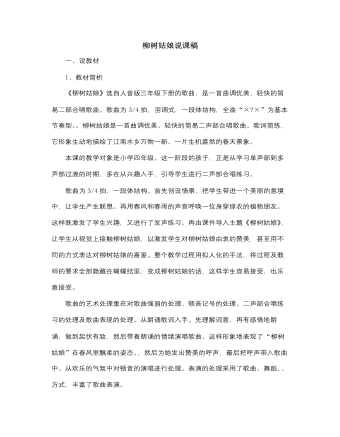
人音版小学音乐三年级下册柳树姑娘说课稿
设计意图:这是本课的重点内容。先让学生装扮风雨声赞美柳树,在这个过程中学会歌曲旋律.采用打击乐器或小手为歌曲伴奏,使学生更生动的表现歌曲的美感,丰富了审美体验。让学生在听、读、唱、动等情感体验活动中感受音乐、欣赏音乐和表现音乐。③学唱二声部设计意图:学生在学会歌曲后,欣赏录音注意二声部进入的位置,让学生先唱一声部,教师示范唱二声部.然后利用多种形式进行合唱练习。让学生感性认识音乐要素变化,在音乐中起到的作用,增加了知识性和趣味性,同时达到巩固歌曲的目的。6、律动表演,情感升华。在教学的尾声教师创设教学情景,启发学生植树,请两位同学模拟植树场景,其余的学生以他们为中心围成圆圈,用最好听的歌声和最优美的动作来祝福小树苗快快长高。设计意图:这是本课情感态度价值观目标的拓展。通过课堂上的植树活动,潜移默化地教育学生“爱护树木,关注环保”,从我做起,从现在做起。
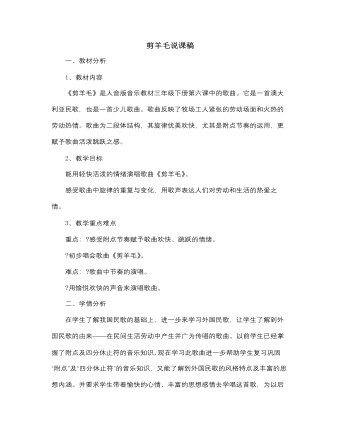
人音版小学音乐三年级下册剪羊毛说课稿
此环节为本课教学最后一个环节,在引导学生在感受歌曲情绪,理解歌曲内容、风格特点的基础上,通过运用综合艺术的教学手段,让学生听中创,创中编,于创编中丰富学生在其情感体验,提高其对音乐的表现力。(五)课堂小结:这节课我们感受到了歌曲欢快、活泼的情绪,体会到了劳动创造幸福的真谛。希望同学们能用自己的双手创造出自己的幸福生活。(六)听音乐出教室这一环节与开头听音乐进教室互相呼应,使课堂气氛活跃,让学生在兴趣盎然中学会了歌曲,全面实现了本课时的教学目标。六、效果预测:本节课的教学中,利用多媒体制作的课件,从视觉、听觉、感觉去理解歌曲,发挥他们的想象力.看中听,听中辨,练中听,听中做,听中创,创中编达到自己领悟,发挥独创精神.运用了模唱法、听唱法、学唱法去陶冶他们的情操。
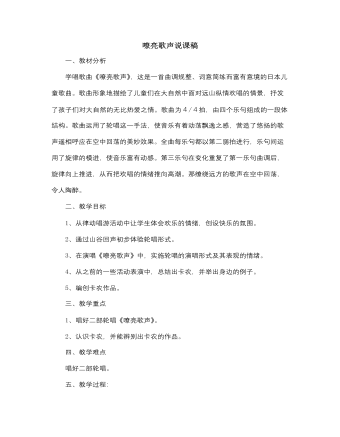
人音版小学音乐三年级下册嘹亮歌声说课稿
教学内容教法学法意图四、揭示课题(一)、揭示课题1、师:以前我们唱歌都是大家一起唱,那叫齐唱,大家能不能帮我们今天演唱的这种形式取个名字呢?(轮唱)2、师:那谁能简单的说一下轮唱要怎么样演唱?3、学生举出其它的卡农例子。(二)、听辩游戏:给出四段音乐,请学生欣赏并辨别哪一段是卡农曲?教师小结。把自己通过亲身体验的感受用语言归纳课题—轮唱,并从轮唱引伸到卡农。让学生学会自己总结,培养学生自主的学习方式。五、创编拓展(到了第三个景点“三宝树”)1、分组编创卡农节目,可以是做动作、读歌词、打节奏等等,也可结合歌曲《法国号》编创轮唱。2、分组展示。3、教师小结把自己的作品表现出来。培养学生协作探索、自主学习的能力。

人音版小学音乐三年级下册甜甜的秘密说课稿
歌曲处理部分我采取了对比式的教学方法,由于此曲有两遍“悄悄地、悄悄地、悄悄地”,而前后两遍的旋律是有变化的,相似之中又有不同之处,在演唱过程中我单独拿出这两个旋律进行视唱对比,让学生自主听辨,这样帮助孩子更好、更准确的演唱。这一环节我主要采取探究式和对比式两种教学方法。我的第四环节是“动”情——感动之情,首先在欣赏前我把老师比作米兰,然后提出疑问“为什么把老师比作米兰而不是蜡烛、春蚕呢?”让孩子们在歌曲中找到答案。孩子们聆听这首歌曲后,我问学生“你把老师比作什么?为什么呢?”探索学生的心声,然后在师与生的相互探讨中让孩子们懂得一支粉笔写就人生的轨迹;两鬓染霜谱成人生绚丽的乐章;三尺讲台留下人生的灿烂和辉煌!这就是我们可敬的老师。最后我朗诵了一首配乐诗朗诵歌颂老师,让孩子和我的心中都漾起那份沉甸甸的师母般的爱。
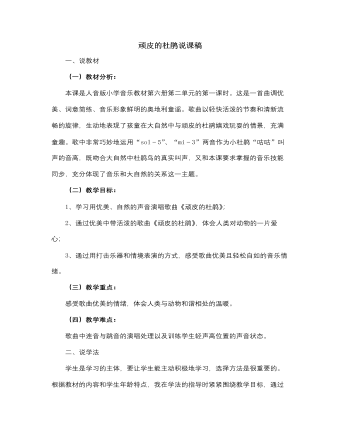
人音版小学音乐三年级下册顽皮的杜鹃说课稿
(三)教学重点:感受歌曲优美的情绪,体会人类与动物和谐相处的温暖。(四)教学难点:歌曲中连音与跳音的演唱处理以及训练学生轻声高位置的声音状态。二、说学法学生是学习的主体,要让学生能主动积极地学习,选择方法是很重要的。根据教材的内容和学生年龄特点,我在学法的指导时紧紧围绕教学目标,通过“听”“唱”“动”“奏”“演”相结合的方法,调动学生的积极性,使每位学生都参与到活动中来。用听唱法和接唱法(师生接唱、男女生接唱、小组接唱)学习歌曲,更容易调动学生学习的兴趣,有利于学生学习歌曲。三、说教法在教学中我主要采用情景教学法、欣赏法和练习法,运用音乐教学光盘,利用其视听结合,声像一体,形象性强的优点,为学生创设一个春的环境。在这种环境中,让学生感受自然的美、音乐的美。针对三年级学生好玩、好动的心理,我还编配了动作,既解决了难点,也实施了寓教于乐的教学策略。
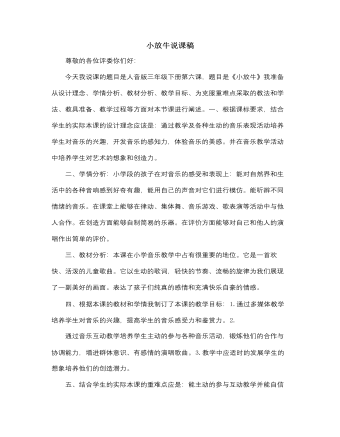
人音版小学音乐三年级下册小放牛说课稿
有感情就有想象,从而形成创造思维。老师可依据本课的内容及情绪鼓励引导学生进行即兴创编活动。充分挖掘学生的潜力。创编一些与课本情绪一致的节奏、诗歌、故事、游戏、音乐表演等。(创编的内容和形式可以根据教材而定)根据学生的个性差异对每一位同学都应该多关心多鼓励。构建和谐团结民主的氛围。引导学生积极讨论共同参与,培养学生乐观的学习态度和友爱的精神。锻炼合作与协调能力,增进群体意识,培养团队精神。第五环节:自评互评培养鉴赏力本课的教学评价我是以表扬和鼓励为主,随时引导学生在音乐活动中开展自评互评和老师的随堂评价,以提高学生的乐感和审美能力。我评价他们的重点是能否积极自信的参与音乐表现、能否与其他的同学协作配合、在课堂小结时我还安排了学生谈一谈这节课的感想如:这节课你学到了什么?歌曲中你最喜欢那一句?在课堂上对那些有创意的学生我还及时的发给他们小奖品。小结:以上是本课的总阐述,不到之处请评委指正。
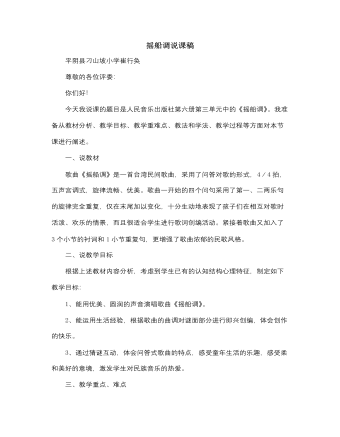
人音版小学音乐三年级下册摇船调说课稿
接着,采用师生对唱,男女对唱、领唱等不同的演唱方式来巩固歌曲,在整个学唱过程中,我随时进行难点、错误的纠正,通过声情并茂的演唱示范,指导学生能用优美、圆润的声音演唱全曲,并通过歌曲中反复出现的“圆圆”二字,激发学生的爱国之情。环节三:拓展延伸,创编谜语对于三年级的学生来说,创编歌词并非是一件容易的事,但是新课程标准明确指出,音乐教师应该培养学生的创编能力,而且《摇船调》这首歌曲的前半部分很适合学生进行歌词创编活动。为了降低难度,我首先示范事先创编好的第一段歌词,让学生按照自己的意愿自由组合创编,学生结合生活常识猜出谜底,然后将自己编创的《新摇船调》表演出来,并在《摇船调》优美的音乐中结束课堂。以上就是我对这节课的教学设计,如有不足之处,敬请各位评委老师批评指正。谢谢!
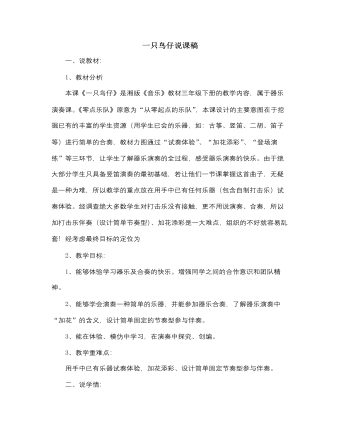
人音版小学音乐三年级下册一只鸟仔说课稿
五、教学反思本节课我力求做到“既面向全体,又发展个性”,始终把学生摆在首要地位,注重学生的自主、与探究,总的来说达到了预期的教学目的。但还存在很多的缺憾,目前我们学校的状况是这样的,音乐课已停了一个多月,在准备艺术节的节目,学生在以往只有竖笛的基础入门,有的甚至连门都没进,而我是第一节课,在抽签后刚进到教室,学生就得去吃早餐,我根本不来不及了解学生的一些具体情况,再加上后来又是分组,又是安排座位,本人的教学机智也不够,没利用好课前的几分钟让学生去熟悉旋律,这就直接导致后来课堂上旋律声部明显薄弱,不够突出,另外,古筝的音有点偏低,古筝一般演奏D、G调作品,用来演奏C调,因略偏低,其实昨天我们付出了很大的功夫调弦,甚至把弦都调断了,一个个音都拿校音器校了,和校音器是准的,但就是和钢琴差那么一点,没办法,这只说明我还得加强学习,在这方面研究少了。
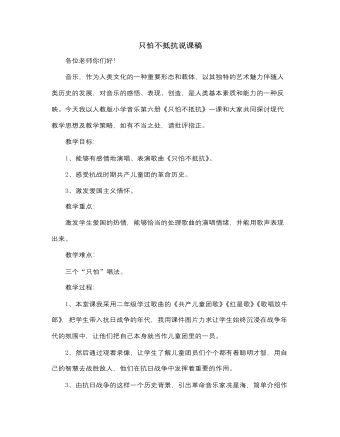
人音版小学音乐三年级下册只怕不抵抗说课稿
5、在学习歌曲时,我遵循音乐新课程改革中“学生自主学习”这一教学模式,并将这一模式贯穿于整个教授新歌的过程中。让学生通过两遍的聆听后让学生充分感受歌曲的情绪,并且让学生充分感受到儿童团员们不畏强暴,英勇杀敌的战斗精神。之后,让学生采用自主式学习方式,挑选出自己喜欢的乐句学唱,并让学生自己给歌曲创编动作,初步学唱之后自己找难点并且大家一起解决,在歌曲难点三个“只怕”的演唱,采用对比的方法,帮助学生更快更准确解决难点。把歌曲学会之后,通过两部队比赛的方式,鼓励学生更加有激情地演唱歌曲和考查学生对歌曲的熟练程度。最后进行儿童团抗日战斗表演既全班完整演唱歌曲,让学生能用歌声恰当的表达出歌曲演唱情绪。6、最后小结,通过谈话指导学生要珍惜着来之不易的幸福生活,学习小英雄们顽强拼搏,勇往直前的精神,加强了学生从小努力学习,长大建设祖国的教育意义。
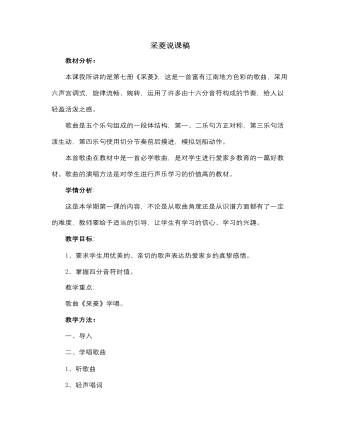
人音版小学音乐四年级下册采菱说课稿
在歌曲学习中,由于歌曲节奏疏密相间,运用了许多十六分音符构成的节奏型以及切分节奏,因此节奏是个难点。在演唱过程中,我发现学生对十六分音符和切分音符这两个节奏很难掌握,因此,我先让学生学习这两个节奏,并设计了两条节奏让学生练习,让他们拍手打节奏,使他们熟悉节奏的特点,再用到歌曲中,这样学生在学唱的时候脑子里就有了初步的印象。另外,四年级学生的识谱能力较弱,在看到旋律的时候不能一下就反应出来,尤其是这种旋律和节奏较为复杂的歌曲,所以,我尽量让学生以听范唱为主,跟着录音一起把歌曲唱好。为了解决歌曲中切分节奏,我采用请学生模仿教师拍节奏、师生对拍、接龙拍击等方式解决,在活动中适时地填入歌词(山中的清泉香喷喷;湖里的水菱甜又香),并加入小间奏边拍边读(学生容易忽视小间奏);听教师演唱学生在小间奏处拍手;最后过渡到学生听琴演唱而小间奏处用高八度音伴奏等,学生在和教师的互动中不仅学得津津有味,而且效果非常好。
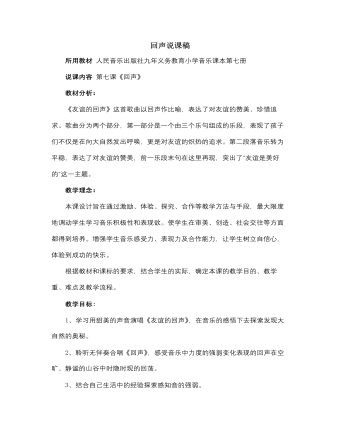
人音版小学音乐四年级下册回声说课稿
①教师范唱歌曲旋律。②随教师轻声视唱歌曲的旋律。③随琴演唱歌曲的旋律。5、学习歌词:①把歌词以诗歌的形式展现出来,请一名同学有感情地朗读歌词。②全体学生按女声、男声、合这一要求朗读歌词。[设计意图:注重音乐与相关学科的整合,帮助学生提高理解音乐、表现音乐的能力。]6、随音乐轻声填词。7、完整演唱歌曲。8、问:为什么称“友谊的回声”?这首歌曲以回声作比喻,表达了对友谊的赞美,同时告诉我们要珍惜身边的友谊。四、扩展升华1、问:除了回声部分有力度变化外,还可以根据歌词加入哪些力度变化呢?[设计意图:让学生根据自己对歌曲及力度变化的理解,为歌曲加入适当的力度记号,鼓励学生对音乐有独特的见解,激发学生创作的兴趣,培养学生的音乐鉴赏能力。]

人音版小学音乐四年级下册森林的歌声说课稿
6、然后模唱《森林的歌声》中的三段主旋律,并通过模唱、模仿乐器演奏等方式分别熟悉三段旋律。7、乐曲当中的三段主旋律的听辨,是本节课的重难点,所以我通过各种方式让学生去熟悉,如:模唱、表演唱等,让学生通过不同的形式去熟悉各段主旋律。由于这三段旋律情绪上的区别不是很大,所以学生比较容易混淆,所以所以我采用让学生动笔记录音乐的方式,来更准确的区分音乐。8、紧接着老师介绍这么美丽动听的音乐来自大森林,可是人们却不珍惜它,用幻灯片展示一组人们乱砍乱筏,肆意掠杀动物的图片。激起学生内心的对坏行为的愤怒,也唤醒学生保护环境的意识。9、老师带领学生用自己的方式来尽一份力,来呼唤更多的人保护环境。老师把本节课的3歌主题加入歌词,请学生来演唱、录音,来宣传保护环境,呼吁人们留住美好的大森林。
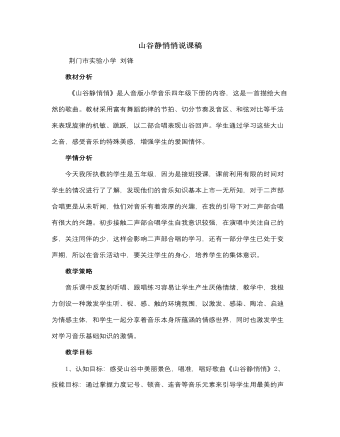
人音版小学音乐四年级下册山谷静悄悄说课稿
教材分析《山谷静悄悄》是人音版小学音乐四年级下册的内容,这是一首描绘大自然的歌曲。教材采用富有舞蹈韵律的节拍、切分节奏及音区、和弦对比等手法来表现旋律的机敏、跳跃,以二部合唱表现山谷回声。学生通过学习这些大山之音,感受音乐的特殊美感,增强学生的爱国情怀。学情分析今天我所执教的学生是五年级,因为是接班授课,课前利用有限的时间对学生的情况进行了了解,发现他们的音乐知识基本上市一无所知,对于二声部合唱更是从未听闻,他们对音乐有着浓厚的兴趣,在我的引导下对二声部合唱有很大的兴趣。初步接触二声部合唱学生自我意识较强,在演唱中关注自己的多,关注同伴的少,这样会影响二声部合唱的学习,还有一部分学生已处于变声期,所以在音乐活动中,要关注学生的身心,培养学生的集体意识。
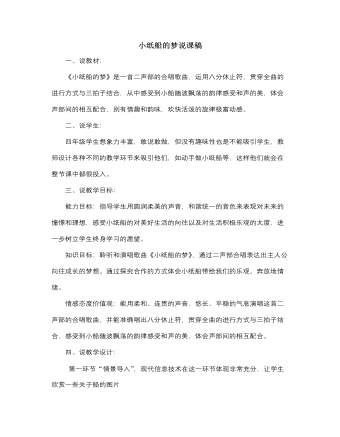
人音版小学音乐四年级下册小纸船的梦说课稿
第一环节“情景导入”,现代信息技术在这一环节体现非常充分,让学生欣赏一些关于船的图片第二环节“反复感受,轻松学歌”,音乐是听觉的艺术,在这一环节中,我首先让学生通过反复聆听来感受这首歌曲,接着采用模唱法和听唱法相结合让学生在轻松愉快的氛围中学会了本课歌曲。第三环节“表现歌曲”这是本课中最出彩的一个环节。在前面的几个环节中层层铺垫,为学生积累了很多艺术实践和经验,这时让学生拿着自己的船进行音乐表现,学生已经没有困难,而且能够表演得很到位,将整堂课推向高潮。最后的拓展部分引发学生对祖国热爱,激励他们努力学习而使学生喜欢音乐,感受音乐带给我们的美以及对未来的憧憬和理想。让他们在以后的学习生活中能奋发向上!

